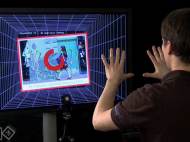Fraunhofer FIT’s 3D gestural information interaction system
 Scientists at Fraunhofer FIT have developed a non-contact gesture and finger recognition system that could be used as a future information interaction system. The novel system detects hand and finger positions in real-time and translates these into appropriate interaction commands. Unlike most of the systems we described before, this system does not require special gloves or markers and it is capable of supporting multiple users.
Scientists at Fraunhofer FIT have developed a non-contact gesture and finger recognition system that could be used as a future information interaction system. The novel system detects hand and finger positions in real-time and translates these into appropriate interaction commands. Unlike most of the systems we described before, this system does not require special gloves or markers and it is capable of supporting multiple users.
The developer of FIT prototype claims it provides the next generation of gesture-based interaction that is more advanced than the system seen in the sci-fi movie named Minority Report. The FIT prototype tracks the user’s hand in front of a 3-D camera. The 3-D camera uses the time of flight principle, in this approach each pixel is tracked and the length of time it takes light to be filmed traveling to and from the tracked object is determined. This allows for the calculation of the distance between the camera and the tracked object.
“A special image analysis algorithm was developed which filters out the positions of the hands and fingers. This is achieved in real-time through the use of intelligent filtering of the incoming data. The raw data can be viewed as a kind of 3-D mountain landscape, with the peak regions representing the hands or fingers.” said Georg Hackenberg, who developed the system as part of his Master’s thesis. In addition plausibility criteria are used, these are based around: the size of a hand, finger length and the potential coordinates.
A user study was conducted and found that the system both easy to use and fun. However, work remains to be done on removing elements which confuses the system, for example reflections caused by wristwatches and palms which are positioned orthogonal to the camera.
“With Microsoft announcing Project Natal, it is likely that similar techniques will very soon become standard across the gaming industry. This technology also opens up the potential for new solutions in the range of other application domains, such as the exploration of complex simulation data and for new forms of learning,” predicts Prof. Dr. Wolfgang Broll of the Fraunhofer Institute for Applied Information Technology FIT.









Leave your response!